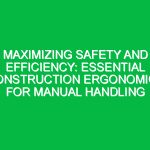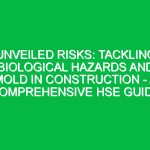When it comes to ensuring the safety and well-being of workers in any industry, Health Safety and Environment (HSE) professionals play a pivotal role. One of the critical responsibilities of HSE professionals is to develop and implement effective site-specific safety orientation programs. These programs are not just about ticking boxes; they are about instilling a culture of safety, awareness, and responsibility among all employees. In this article, we will delve into the secrets of creating effective site-specific safety orientations and provide essential tips for HSE professionals to enhance their safety training programs.
Understanding the Importance of Site-Specific Safety Orientation
Before diving into the strategies for developing effective safety orientations, it’s crucial to understand why they are so important. Site-specific safety orientations are tailored to address the unique hazards and safety protocols of a particular workplace. This customization ensures that employees are not just receiving generic safety information but are being educated on the risks and safety practices that are directly relevant to their work environment. This relevance increases the likelihood of information retention and compliance, ultimately reducing accidents and injuries on site.
Key Components of an Effective Safety Orientation
An effective site-specific safety orientation should include several key components:
- Comprehensive Hazard Assessment: A thorough evaluation of all potential hazards present on the site.
- Emergency Procedures: Clear instructions on what to do in case of an emergency, including evacuation routes and assembly points.
- Personal Protective Equipment (PPE) Requirements: Detailed information on the necessary PPE for various tasks and how to properly use it.
- Reporting Procedures: Guidelines on how to report accidents, injuries, and near misses.
- Behavioral Expectations: Outline of the expected behaviors in terms of safety practices and compliance.
Essential Tips for HSE Professionals
Now that we’ve established the importance and components of a site-specific safety orientation, let’s explore some essential tips for HSE professionals to make their safety orientations more effective:
Tip #1: Engage Your Audience
Engagement is key to ensuring that your audience retains the information presented during the orientation. Use interactive methods such as quizzes, group discussions, and hands-on demonstrations to keep participants active and engaged.
Tip #2: Utilize Real-Life Scenarios
Incorporating real-life scenarios and case studies can make the orientation more relatable and impactful. Sharing stories of actual incidents can help underscore the importance of following safety protocols.
Tip #3: Keep It Relevant and Concise
While it’s important to cover all necessary information, avoid overwhelming participants with too much detail. Focus on the most relevant hazards and safety practices for the specific site, and present the information in a clear and concise manner.
Tip #4: Continuously Update Your Orientation Program
Workplaces evolve, and so do their hazards. Regularly review and update your safety orientation program to reflect any changes in the work environment, processes, or regulations.
Tip #5: Leverage Technology
Technology can be a powerful tool in delivering effective safety orientations. Consider using e-learning platforms, virtual reality simulations, or mobile apps to provide a more immersive and flexible learning experience.
Implementing Feedback Mechanisms
Feedback is crucial for continuous improvement. Implement mechanisms to gather feedback from participants on the effectiveness of the orientation. This feedback can provide valuable insights into areas that may need adjustments or enhancements.
Conclusion: Creating a Culture of Safety
Effective site-specific safety orientation is not just about imparting knowledge; it’s about building a culture of safety where every employee feels responsible for their own safety and the safety of their colleagues. By engaging your audience, utilizing real-life scenarios, keeping content relevant and concise, continuously updating your program, and leveraging technology, HSE professionals can significantly enhance the effectiveness of their safety orientations.
Remember, the goal of site-specific safety orientation is not just compliance but fostering an environment where safety is ingrained in every aspect of the workplace. By following these essential tips, HSE professionals can unlock the secrets to creating impactful and effective safety orientations that not only comply with regulations but also save lives.
Summary of Key Points
- Site-specific safety orientations are crucial for addressing the unique hazards of a workplace.
- Effective orientations should include hazard assessments, emergency procedures, PPE requirements, reporting procedures, and behavioral expectations.
- Engaging the audience, using real-life scenarios, keeping content relevant, updating the program, and leveraging technology are essential strategies for enhancing safety orientations.
- Feedback mechanisms are important for continuous improvement of the orientation program.
- The ultimate goal is to create a culture of safety where every employee prioritizes their own safety and the safety of others.


